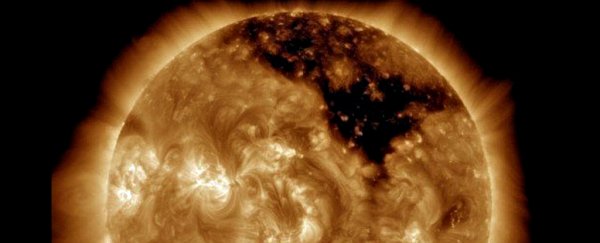A NASA spacecraft just spotted a giant hole creeping over the surface of the Sun. It sounds like the recipe for a doomsday blockbuster - the Sun slowly gets consumed by blackness, throwing our planet into a cold, dark frenzy. But actually, this hole is no cause for alarm.
It's called a coronal hole, an astronomical phenomenon that pops up on the sun's corona (atmosphere) from time to time.
According to NASA, these holes mark low-density spots where the sun's magnetic field opens freely into interplanetary space, allowing hot material from the corona to speed outward. Because of this, the areas have much less hot plasma than their hotter, brighter surroundings, causing them to appear dark and, well, 'hole-y'.
Using a series of images released by NASA, Tom Yulsman of Discover's ImaGeo blog notes put together a short animation showcasing the massive hole.

"Coronal holes are the source of a high-speed wind of solar particles that streams off the sun some three times faster than the slower wind elsewhere," NASA says. They can appear anywhere from weeks to months at a time, and can take up as much as a quarter of the sun's surface.
Even though a coronal hole on the sun doesn't signal the end of the world, it can lead to a few pesky problems back on Earth.
"Solar winds released from the corona can form solar storms, which can disrupt satellite and radio communication systems," the Huffington Post reports.
This article was originally published by Business Insider.
More from Business Insider:
